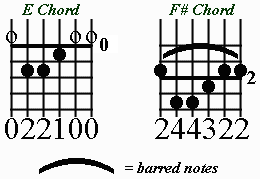
Barre Chord Theory
Barre chords are an integral part of guitar. They are somewhat difficult to execute, but the theory behind them is very simple. In this lesson I will attempt to explain the theory behind barre chords so you will be able to create any barre chord you want to (even Eb7sus4). You should be able to at least play barre chords before reading this page. If you want to learn how to play barre chords, or are having trouble playing them, try my page on playing barre chords. Once you know how to play them, this page will be a gold mine.
Barre chords are basically E and A chords moved up the fretboard by using your barred finger as the nut. For example, and F# chord is the same as an E chord moved up 2 frets:

Therefore, if you want to make an F# barre chord minor, you do the same thing you would do to an E to make it minor. Since an Em chord is played 022000, the F#m is the same thing moved up 2 frets: 244222. The same thing will happen once we start talking about the A-chord-derived barre chords. For this page you will need to know the notes on the 5th and 6th strings up to the 12th fret. The diagram below outlines the position of these notes on the fretboard. Keep referring to it throughout this page.

Now that you have a background of what we are talking about, I will go into more detail on barre chords. There are two main types of barre chords: E-derived and A-derived. I will discuss E-derived barre chords first.
E-derived barre chords are produced by moving an E-type chord up the fretboard using your barred finger. For each E-derived barre chord I will use F# as the example but the ideas used in each example will apply to all E-derived barre chords. As is apparent in the F# chord shown below, the bass F# appears on the sixth string.

Let's say you moved the F# barred shape up 2 frets. The note played on the sixth string would then be G#, and therefore the chord you play is G# (466544). If you want to make an A# chord, you simply make the same chord shape at the fret where there is an A# on the sixth string, which is 6th fret. So an A# chord is played like this: 688766. This applies to any chord; if you want a C#, then play at the 9th fret. This is the basis of barre chords: if you know where your bass note is then you can play any chord you want.
Now I will discuss the changes in barre chords to make them minor, sevenths, etc. I will simply list the different changes that can be made and the appropriate fingering of the corresponding F# chord. To see why these fingerings make chords minor, seventh, etc., read the other pages that I have provided on those topics. All these changes can be applied to any barre chord as mentioned above; simply play them at a different fret. This table is arranged so that the more important chords appear at the top and obscure chords appear at the bottom.
F#m F#7 F#m7 F#sus4 F#7sus4 | dansm rules | 244322 244222 242322 242222 244422 242422 |
Now I will discuss A-derived barre chords. These chords are formed by taking the A shape and moving it up the fretboard by barring. I will use a B chord to illustrate these chords. As you can see below, the B bass appears on the fifth string.

Therefore, to move A-derived barre chords, you must look for the bass note on the fifth string. If you want to play an Eb chord, for example, play at the sixth fret, x68886. Here is a list of the same changes shown above, plus two more which are easy on A-derived chords but difficult on E-derived chords.
Bm B7 Bm7 Bsus4 Bsus2 B7sus4 Bmaj7 |
dansm rules | x24442 x24432 x24242 x24232 x24452 x24422 x24252 x24342 |
As above, these changes can be moved to any fret to make different chords; just find the bass note you need. That's about it for barre chords. Have fun and I hope this has helped!
Back to Dansm's Guitar Chord Theory
You are visitor number
© 1997 Daniel E. Smith.